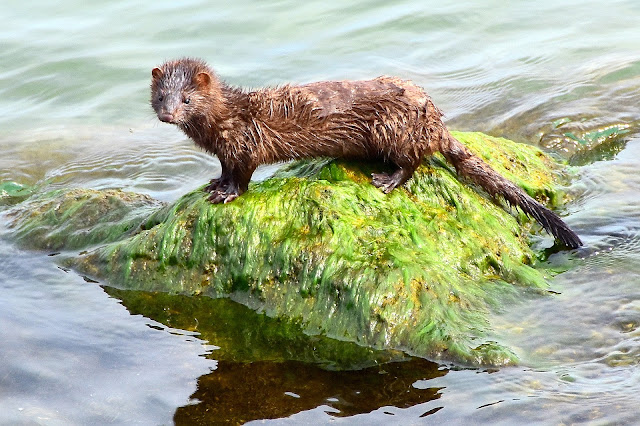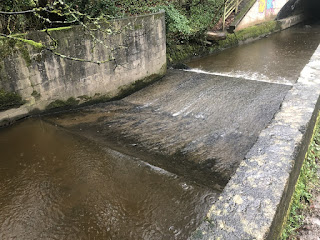Invasive Non-native Species on the Douglas (Part 2: Fauna)
In a previous blog, I highlighted some of the most threatening invasive species of plant that can be found on the River Douglas. In this blog, I'd like to draw attention to some of the Douglas' most menacing animal species. As explained in my last blog, non-native invasive species upset the delicate balance of ecosystems when introduced to new habitats.
Sadly not all non-natives species have such a harmonious relationship with their environment, and many have the potential to cause a great deal of damage. See below for a list of the top offending non-native animal species found along the River Douglas.
American mink (neovison vison)
 |
| Credit:Pixabay |
Origin: North America and Canada. American mink were initially imported by British fur farms, but many would escape establishing a naturalised British population. They can now be found in Europe, Asia and South America.
Diet: Carnivorous. Feeding on mammals, fish and birds. Mink are opportunistic predators and will eat whatever they can. They have been known to take prey as big as seagulls.
UK Distribution: American mink can now be found across the British Isles, excluding some rural areas of Scotland.
Habitat: Mink are found near water as they are semi-aquatic mammals and rely on freshwater habitats for much of their prey. They can be found along rivers, wetlands and coastal areas. American mink dwell in burrows that have often been stolen off of other animals and will often line them with leaves, grass or the fur of their prey.
Breeding: American minks are polygamous and will breed with multiple partners during mating season. Gestation takes between 45 and 75 days and will produce litters of around five or six kittens by late Spring. They begin mating between 10 and 12 months old.
Identification: Minks are a part of the Mustelid family and have a slender body similar to a ferret or otter. They have dark chocolate coloured fur. Females can weigh up to 800g, with males weighing up to 1.5kg. Sometimes, American mink sightings are confused with Eurasian otter sightings. However, mink are much smaller, measuring between 46cm and 70cm long.
Threatening Qualities: The American mink's ability to establish itself as a highly effective predator/killing machine is its most threatening feature. Female and juvenile minks are small enough to invade water vole burrows, a species of a protected semi-aquatic rodent that is listed as endangered. Furthermore, minks pose a significant threat to ground-nesting water birds. They are quite literally sitting ducks.
Control: Sightings can be reported to local wildlife charities, such as Wildlife Trust, who may decide to take action. However, it is also legal to trap Mink in the UK and control populations yourself. There is a comprehensive guide on ethical and effective trapping created by Sussex Wildlife Trust that can be found here.
Zebra Mussels (Dreissena polymorpha)
 |
| Credit: NOAA Great Lakes Environmental Research Laboratory / FLICKR |
Diet: Zebra Mussels feed on plant plankton. Zebra mussels are filter feeders. They utilise a biological filtration system to extract suspended matter, such as plant plankton, from water. However, many other organisms rely on plant plankton for food, including juvenile fish and other indigenous species of mussels.
UK Distribution: Zebra Mussels are common throughout England but are less common in the other countries of the UK.
Habitat: Zebra mussels are a freshwater species and can be found in still, or slow-moving waters, such as lakes, rivers, and even water treatment works. They can attach themselves to hard surfaces, including rocks, intake pipes, boat hulls, anchors, piers, and larger unionid mussels.
Identification: Around 30mm in length, usually no bigger than a penny. They have a triangular shape. The shell is usually a beige or yellow with dark zig-zagging stripes. However, some lack the iconic pattern and can appear to be darker. They form large clusters and are found in groups.
Threatening Qualities: One of the main problems with zebra mussels is their excess and ability to reproduce quickly. They outcompete indigenous mussels for resources such as plankton and take over freshwater areas, which could lead to the extinction of certain species. Zebra mussels can instigate biomagnification, in which harmful chemicals are passed upwards in the food chain. Zebra mussels filter harmful contaminants in the water, which they pass on to their predators when preyed upon. The filtration also leads to greater water clarity, allowing sunlight to penetrate deeper into the depths and cause algal blooms, leading to the production of hazardous toxins.
In addition, zebra mussels can damage water treatment works and boating equipment. They also cut swimmers on the razor-sharp shells left behind after they have perished. Furthermore, they can grow on top of each other forming massive crusts of multiple mussels that can suffocate other molluscs and crustaceans and block water passages.
Breeding: Eggs are released when waters rise to 12°C, with females capable of releasing batches of up to 40,000 four times per breeding season. Eggs hatch into microscopic larvae, which can travel in the water before metamorphosing into their adult form. Larvae are microscopic and able to spread long distances through water networks.
Signal Crayfish (pacifastacus leniusculus)
 |
| Credit: David Murray-Smith/ FLICKR |
Origin: Like the American mink, the signal crayfish originates from North America. Specifically in the regions between the Rocky Mountains and the Pacific Ocean. However, they have spread to areas such as Nevada and California, where they are viewed as invasive.


Comments
Post a Comment